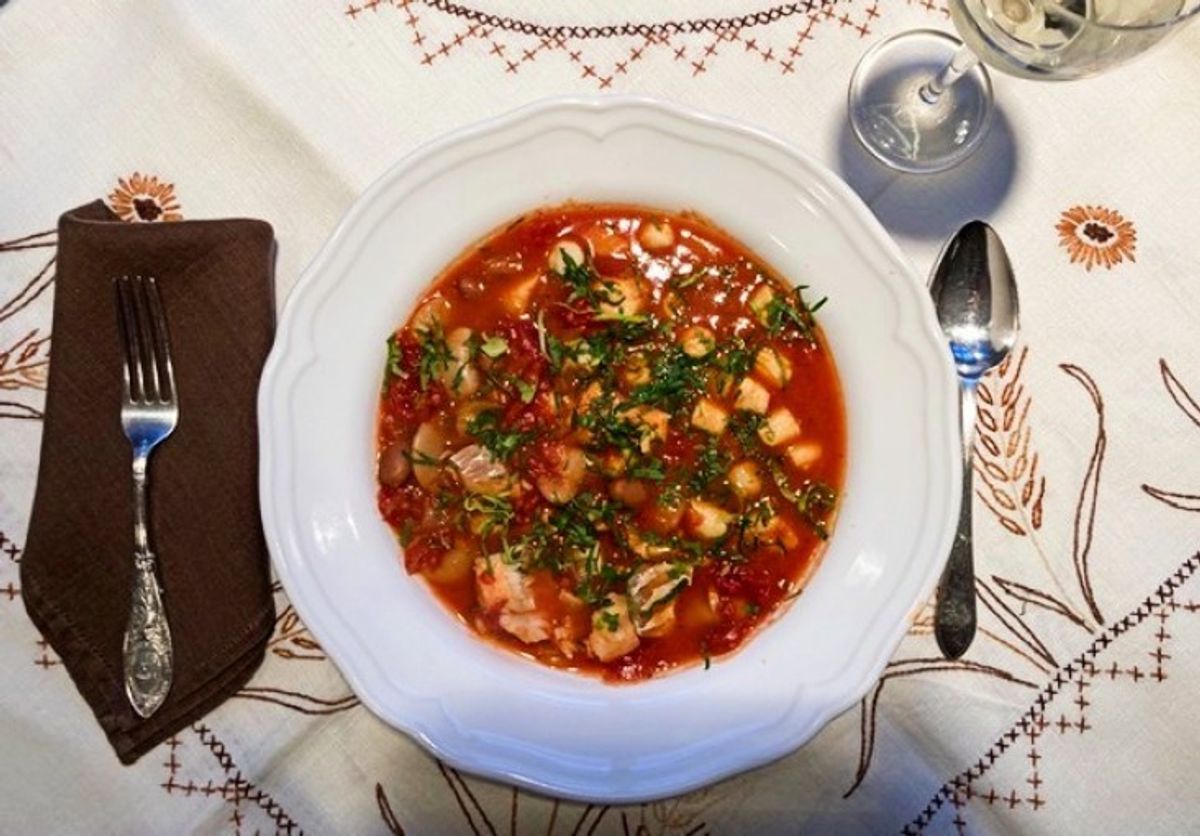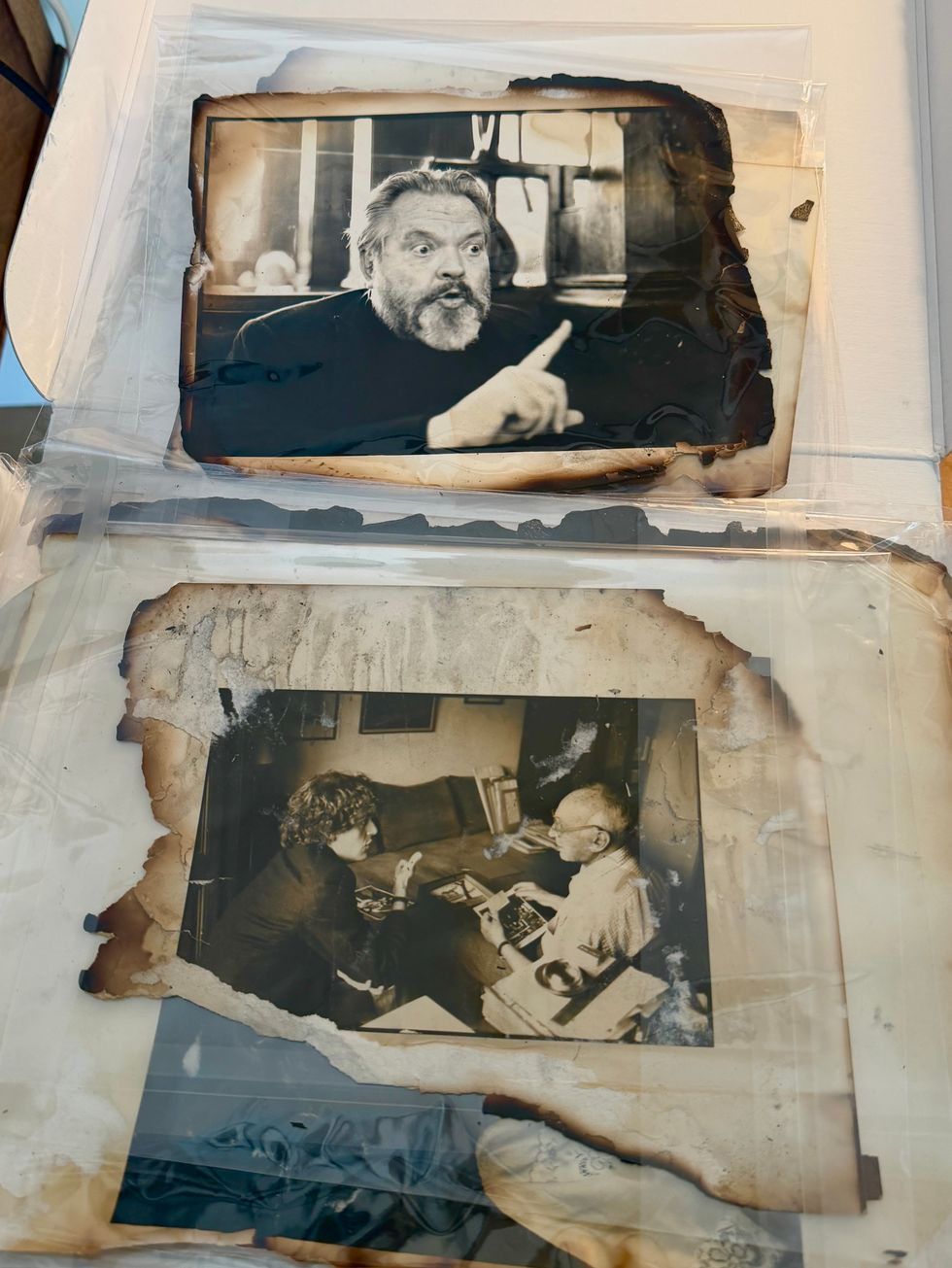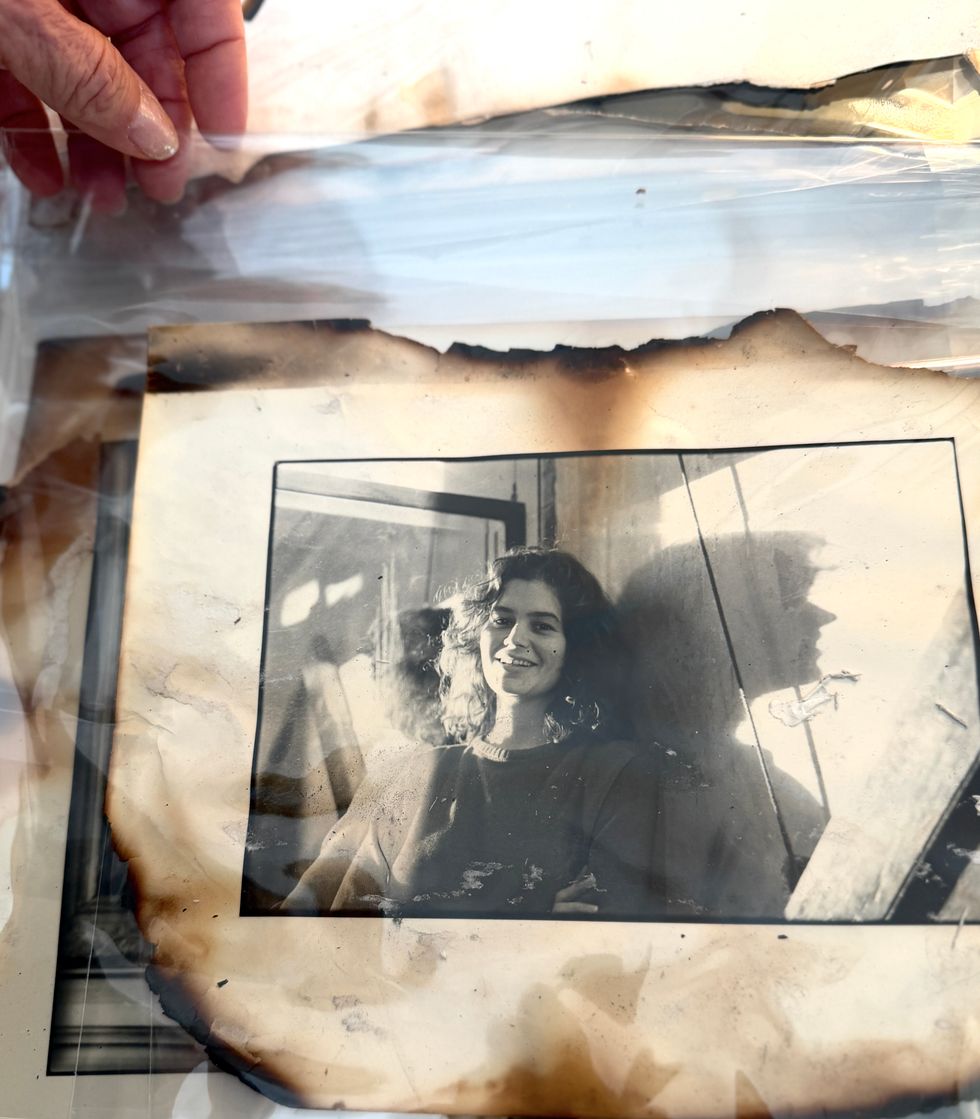Sun all day, Rain all night. A short guide to happiness and saving money, and something to eat, too.

Pamela Osborne

If you’ve been thinking that you have a constitutional right to happiness, you would be wrong about that. All the Constitution says is that if you are alive and free (and that is apparently enough for many, or no one would be crossing our borders), you do also have a right to take a shot at finding happiness. The actual pursuit of that is up to you, though.
But how do you get there? On a less elevated platform than that provided by the founding fathers I read, years ago, an interview with Mary Kay Ash, the founder of Mary Kay Cosmetics. Her company, based on Avon and Tupperware models, was very successful. But to be happy, she offered,, you need three things: 1) someone to love; 2) work you enjoy; and 3) something to look forward to.
Like a lot of advice — to lose weight, for example, eat less and exercise, that’s one I’ve heard a few times — this is deceptively and falsely simple. It’s pretty hard, really, to be lucky enough to enjoy your work day in/day out. And given divorce rates, it seems that someone to love can be a bit scarce on the ground, too, and so this category may need to be expanded to include whatever else you might be able to love. The last condition — something pleasing on the horizon— is, perhaps the one most able to be made to happen. Vacations on the high end, looking out the window or a good night’s sleep on the low.
What Mary Kay failed to mention is how very difficult it is to have all three of these things working for you at the same time. It’s tough. So best not to think about that too much, but instead just close our eyes and focus on what might be possible. Small small, that’s the ticket.
Based on what makes some days better for me, and on what is realistic, here’s a suggestion for a low key approach to adding an attainable, achievable something to look forward to to your life. If there’s one thing I don’t look forward to, it’s having to face an evening of standing at the sink and the stove at the end of a long day. Fast food and take-out fortunes have been made by people who figured out how to capitalize on this, to the detriment of neighborhood bank accounts everywhere. Much better to plan ahead, bothering in advance to fix something that’s good and ready to eat at the end of the day, so that all that’s needed is a quick heating up. Look at it as one step taken on the road to a happier few moments as shadows lengthen at the end of the afternoon. Works for me. Well, along with a toast to those who are with us, and to those who are not.
This recipe can be put together from items you may already have on hand. You might want to give it a try, it’s simple and good.
This stew, though served hot, is light, and fine for this still between-seasons time of year.
And, happily, you will find it to be easy and economical. If you are feeling pinched these days, you can leave out the fish and add more beans. In that case, you might want to add fish stock cubes instead of the vegetable stock cubes specified, for a bit of extra flavor. You can, of course, use fresh fish instead of frozen, but that defeats the convenience of having a pantry-available meal. Regardless, and by the way, this is more than good enough to serve to a table of friends, if you choose to do that, and no one, including the cook, will feel hard done by. Or, if it’s just you or a few at the table, make a potful, dip out what you need for a meal, and heat it in the microwave for a few minutes. Keep the rest for an easy tomorrow, it keeps well.
8-10 servings
2 or 3 TB olive oil. A neutral oil is fine. I use Berio.
2 TB unsalted butter
2 sticks celery, halved lengthwise and very finely sliced, just a bit more than paper thin
Some celery leaves from the center of the bunch, rinsed and dried
4 medium shallots, peeled and quartered, OR 1 medium onion—red or yellow—roughly chopped
4 or 5 garlic cloves (small to medium), peeled and very finely sliced. And no, it won’t taste too garlicky: it isn’t smashed or pressed, which intensifies that.
1 1/2 tsp. fennel seeds
A bunch of parsley, washed and dried. You will use the stems for the stew, the leaves for garnish. You want about 3/4 cup finely chopped parsley leaves. Medium chop the stems, 1/4” to 1/3” long.
1/2 c. dry white wine. I used what remained of a bottle; it may have been a bit more than half a cup, and had been sitting in the fridge for several weeks.
2 28-oz.cans of peeled plum tomatoes. I use Cento, and you needn’t buy the more expensive San Marzanos. With my washed hands, I take the tomatoes out of the can one by one and put them in a bowl, having removed the stem end and any stringy bits hanging from it, and any overlooked pieces of skin. Check the remaining tomato liquid for random bits of skin, too, before adding it to the bowl. All of these are indigestible, basically, and removing them improves the end product. But if you don’t care about that, just dump in the can as is. The tomatoes will need to be broken up a bit as you stir, with a wooden or silicone spatula.
One 15.5-oz. can of small white beans, rinsed and drained; Roman, flageolet, navy. I buy Goya.
One 15.5-oz. can of larger white beans, rinsed and drained. Butter beans are good, cannellini would do, too. Again, Goya.
2 cubes of vegetable stock. Mince these into small pieces before adding, they’ll dissolve more quickly.
Two pounds of frozen fish, thawed, rinsed, and cut into largish pieces, as they will break apart when cooking. Use a flaky fish, not a meaty one. I used one package of cod, and one of bay scallops, both bought on sale, which were in my freezer. The scallops (and by the way, in the past bay scallops were considered a delicacy compared to sea scallops, and were much more expensive; the reverse is true now, go figure) were very good, but all cod would be fine, too. If you’re not using fish, rinse and drain another can of beans, add that, see if one additional can is enough. This is not a thick stew, it should be a somewhat thinner, soupyish one. Add another can if you think it might be a good idea. The beans will swell as they cook, and will thicken the broth a bit; so if you’re uncertain, be conservative. You can always add more beans later.
Lemon wedges to serve, with Maldon salt and freshly ground pepper, and hot pepper flakes or oil
Melt the oil and butter in a large pan (a six or seven-quart Dutch oven, for example) over low heat. Add the celery, shallots, fennel seeds, and chopped parsley stems, with a pinch of salt. Cook slowly, stirring frequently, until the shallots and celery are very soft, but not browned at all. When they are nearly soft, add the garlic slices, being careful not to let them burn, and cook to soften. Raise the heat to medium, add the wine and let it simmer for 3 or 4 minutes, and then add the tomatoes, beans, and chopped vegetable stock cubes, which will dissolve. Add a cup of water, if things look too thick. Bring to a boil, turn down the heat, and simmer for about half an hour, stirring periodically.
Add the fish pieces, nestled into the top of the stew. Reduce the heat to low. Cover the pot and let this cook for about ten minutes, no more, until the fish is opaque and flaking. If you are using bay scallops, add them later, cook only 3 to 4 minutes. Once the fish is cooked, you can stir it in.
This should be prepared several hours ahead, so that the beans have mellowed and the seeds have softened. If serving the same day, I leave the base on the stove, covered, and reheat it slowly at dinner time. In that case, don’t add the fish until the base is hot, shortly before you’re serving it. If you have leftovers, keep the casserole in the refrigerator, and dip out and reheat only what you will need at that time.
Wrap the chopped parsley and celery leaves in waxed paper, wrap that in a damp paper towel, and wrap that loosely in plastic wrap. This will keep for several days in the refrigerator, and should be sprinkled over the stew. Serve with lemon wedges, etc., as above, along with some good bread. If you aren’t serving this to a crowd, you will have some easy evenings ahead, with very little to clean up. Cheers!
Sun all day, Rain all night? A friend once told me he’d had a perfect childhood, and this evocative short description of it was the only one offered. So peaceful and simple, and a guide.
Pamela Osborne lives in Salisbury.
CARE GIVER NEEDED: Part Time. Sharon. 407-620-7777.
SNOW PLOWER NEEDED: Sharon Mountain. 407-620-7777.
Weatogue Stables has an opening: for a part time or full time team member. Experienced and reliable please! Must be available weekends. Housing a possibility for the right candidate. Contact Bobbi at 860-307-8531.
Deluxe Professional Housecleaning: Experience the peace of a flawlessly maintained home. For premium, detail-oriented cleaning, call Dilma Kaufman at 860-491-4622. Excellent references. Discreet, meticulous, trustworthy, and reliable. 20 years of experience cleaning high-end homes.
Hector Pacay Service: House Remodeling, Landscaping, Lawn mowing, Garden mulch, Painting, Gutters, Pruning, Stump Grinding, Chipping, Tree work, Brush removal, Fence, Patio, Carpenter/decks, Masonry. Spring and Fall Cleanup. Commercial & Residential. Fully insured. 845-636-3212.
The Villas Cleaning Team: Owner-Operated. Reliable, detailed cleaning by a trusted husband-and-wife team. Homes & Offices. Airbnb. Small Post-Construction. Commercial. Windows. Laundry. Consistent cleaners every time. Competitive rates. Flexible scheduling. Call/Text: 903-918-2390. Dave Villa for a free estimate.
Estate/Tag Sale: 168 Johnson Road, Falls Village CT. Friday Saturday Sunday, December 5th-7th. Total house contents, furniture, antique and vintage collectables, costume jewelry, shed stuff, basement stuff, stairs chairlift, some art. Fri, Sat 9-4 and Sunday 9-noon. A Tommy sale, come and get it!!
PUBLISHER’S NOTICE: Equal Housing Opportunity. All real estate advertised in this newspaper is subject to the Federal Fair Housing Act of 1966 revised March 12, 1989 which makes it illegal to advertise any preference, limitation, or discrimination based on race, color religion, sex, handicap or familial status or national origin or intention to make any such preference, limitation or discrimination. All residential property advertised in the State of Connecticut General Statutes 46a-64c which prohibit the making, printing or publishing or causing to be made, printed or published any notice, statement or advertisement with respect to the sale or rental of a dwelling that indicates any preference, limitation or discrimination based on race, creed, color, national origin, ancestry, sex, marital status, age, lawful source of income, familial status, physical or mental disability or an intention to make any such preference, limitation or discrimination.
Sharon, CT
TAG SALE: SATURDAY, DECEMBER 6, 10:00 AM - 2:00 PM, 135 Sharon Mountain Road, Sharon, CT 06069. Clearing things out before the holidays! Stop by for a great mix of items, including: Kitchenware, Small pieces of art, A few pieces of furniture, Clothing, Books, And more assorted household items. Easy to find, everything priced to sell. Hope to see you there!
Legal Notice
Notice of Formation of Studio Yarnell LLC
Notice of Formation of Studio Yarnell LLC. Articles of Organization filed with the Secretary of State of New York (SSNY) on October 20, 2025. Office location: Dutchess County, NY. SSNY has been designated as agent of the LLC upon whom process against it may be served. SSNY shall mail a copy of any process to: 279 McGhee Hill Road, Millerton, NY 12546. Purpose: Marketing consultancy.
11-13-25
11-20-25
11-27-25
12-04-25
12-11-25
12-18-25
Legal Notice
Notice of Formation of a Limited Liability Company (LLC). The name of the LLC is: Kim’s Business LLC. Articles of Organization were filed with the Secretary of State of New York (SSNY) office on: 11/8/2025. The County in which the Office is to be located: Dutchess. The SSNY is designated as agent of the LLC upon whom process against it may be served. The address to which the SSNY shall mail a copy of any process against the LLC is: 420 Quaker Hill Rd Pawling, NY 12564. Purpose: any lawful activity.
11-20-25
11-27-25
12-04-25
12-11-25
12-18-25
12-25-25
Legal Notice
Notice of Formation of DULCIFY LLC Art. Of Org. filed with SSNY on 09/04/2025. Office Location: 56 South Center Street, Millerton, Dutchess County, NY 12546. SSNY designated as agent of the LLC upon whom process against it may be served. SSNY shall mail process to the Dulcify LLC, 56 South Center Street, Millerton NY 12546.Purpose: Any lawful purpose.
11-27-25
12-04-25
12-11-25
12-18-25
12-25-25
01-01-26
Legal Notice
PLEASE TAKE NOTICE that the Pine Plains Town Board will hold a Special Meeting on December 10, 2025, at 6:00 pm. Said meeting will be held at the Community Center, 7775 Rte.82, South Main Street, Pine Plains, NY 12567. Purpose of the meeting is a public forum about the New Town Hall. The meeting is open to the Public. Dated: November 20, 2025.
BY ORDER OF THE TOWN BOARD
Madelin Dafoe
Town Clerk
12-04-25
NOTICE OF
PUBLIC SALE OF
PERSONAL PROPERTY
GLOBAL SELF STORAGE
Notice is hereby given that the undersigned self storage unit(s) will be sold at a public sale by competitive bidding, in their entirety to the highest bidder, on or after December 26th, 2025, to satisfy the lien of Global Self Storage for rental and other charges due from the undersigned. The said property has been stored and generally described below is located at the respective address. Although, the auction will be held via www.StorageTreasures.com, the sale is made in person at the facility: 3814 Route 44, Millbrook, NY 12545.
Friday, December 26th, 2025
#224 Eva Mort
The terms of the sale will be cash only & must be paid for at the time of sale. All goods are sold as is. Global Self Storage reserves the right to withdraw any or all units from the sale at any time. All contents must be removed within 72 hours or sooner.
12-04-25
12-11-25
PINE PLAINS
TOWN BOARD
NOTICE OF
PUBLIC HEARING
PROPOSED INCREASE IN WATER RATES AND FEES FOR THE PINE PLAINS WATER IMPROVEMENT AREAS
PLEASE TAKE NOTICE that the Pine Plains Town Board shall hold a public hearing on December 18, 2025 at 7:00 p.m. at the Pine Plains Town Hall, located at 3284 Route 199, Pine Plains, New York, on the proposed increase in water user rates and fees for services of the Pine Plains Water Improvement Areas. The proposed water user rates shall be increased from the current minimum usage fee of $45.00 to $50.00 for the first 9,000 gallons recorded, and from $5.80/1,000 gallons to $6.20/1,000 gallons recorded over the initial 9,000 gallons recorded. The purpose of these rate increases is to offset substantial increases in electricity, materials and supplies to operate and maintain the Pine Plains Water Improvement Area Water System. Any person wishing to be heard shall be given an opportunity to do so at said public hearing. A copy of the proposed rate change will be available for inspection at the Town Clerk’s office at regular business hours. Dated: November 20, 2025.
BY ORDER OF THE PINE PLAINS TOWN BOARD
MADELIN DAFOE,
Town Clerk
12-04-25
Anne Day is a photographer who lives in Salisbury. In November 2025, a small book titled “Les Flashs d’Anne: Friendship Among the Ashes with Hervé Guibert,” written by Day and edited by Jordan Weitzman, was published by Magic Hour Press.
The book features photographs salvaged from the fire that destroyed her home in 2013. A chronicle of loss, this collection of stories and charred images quietly reveals the story of her close friendship with Hervé Guibert (1955-1991), the French journalist, writer and photographer, and the adventures they shared on assignments for French daily newspaper Le Monde. The book’s title refers to an epoymous article Guibert wrote about Day.
On Dec. 11, at 6:30 p.m., at the White Hart Inn in Salisbury, Day and Weitzman will share their memories in a conversation moderated by noted designer Matthew Patrick Smyth. The event is organized by Oblong Books and the Scoville Library.
Fresh home from her exhibition and book signing in Paris, Day sat in her Salisbury aerie high above the distant hills, her daughter’s black cat on her lap. She told the story of “Les Flashs d’Anne,” and the kismet that spurred its evolution.
In 2024, afterlearning that Day had worked with Guibert in New York and Paris, Weitzman — the author of numerous books about Guibert —saw her salvaged images, sought her out and announced, “We must do a book together.”
Weitzman writes in the book’s prologue, “This book is the dreamlike, uncanny result of that serendipitous encounter with a remarkable woman.”

During the 1980s, Day was a working photographer living on Fifth Avenue. A friend, the editor of Le Monde, asked whether Guibert, on his maiden voyage to New York, could stay with her. “I remember it was a cold night when Hervé showed up at my door,” she said.“His flight had just gotten in from Paris and he had this big box of Guerlain perfume. It was wrapped in beautiful pink paper. Within four minutes, we were friends.”
Thus began a whirlwind collaboration that took them from Manhattan, where they interviewed André Kertész, to Paris where they dined with Henri Cartier-Bresson and Duane Michals, and on to interviews with Isabelle Huppert, Gina Lollobrigida, designer Madeleine Castaing, Orson Welles and other luminaries of that time.
Day never saw Guibert after 1983. “Hervé got AIDS in the late ’80s and was quite militant. He now has a following of young people,” Day saidwistfully. During his final days, Guibert wrote five books based on his existential journey.

Day recalled the devastating house fire in which her family tragically lost their friend Maria Paz Reyes and their dog. Day survived by jumping from the second story. A lifetime of images, negatives and slides were lost or damaged. “To lose pictures is like losing friends. Everything was piled into metal file cabinets in my studio. All my negatives and slides were packed in tight. The fire started at the farthest point from there as possible. It was the only thing that wasn’t destroyed— every other single thing was gone. Nothing left. It was raining, so my friend Christopher covered everything with a tarp. The fabulous part of this story is how much help I had from my town, which gave me the empty firehouse to lay out everything to dry. Friends came from near and far to help. Some days I had ten volunteers, and it went on for a month, which gave me something to move forward with. It was so tragic and awful.”

A veteran photojournalist, portrait, wedding, and architectural photographer, Day created images for five books featuring the architecture of the Library of Congress, the U.S. Capitol, and the New York Public Library. She covered events in Cuba, Haiti and South Africa, where she took an iconic image of Nelson Mandela emerging from his prison cell. Her commissioned images of four Presidential Inaugurations are featured in the Smithsonian. Her work has appeared in Newsweek, Time, The New York Times, The Washington Post, Fortune, Paris Match and Vogue. She was the editor of Compass at the Lakeville Journal and The Millerton News.
Currently, she enjoys shooting digital photographs of nature. “I am interested in migration, large groups of birds and insects. I’ve been to New Mexico to photograph monarchs, Nebraska to photograph Sandhill cranes, and Ireland to photograph a murmuration of starlings.”
Day summed up her life: “Things just happened to me.”
Tickets to the event at The White Hart Inn on Dec. 11 are available at oblongbooks.com
In 1983, writer and performer Nurit Koppel met comedian Richard Lewis in a bodega on Eighth Avenue in New York City, and they became instant best friends. The story of their extraordinary bond, the love affair that blossomed from it, and the winding roads their lives took are the basis of “Apologies Necessary,” the deeply personal and sharply funny one-woman show that Koppel will perform in an intimate staged reading at Stissing Center for Arts and Culture in Pine Plains on Dec. 14.
The show humorously reflects on friendship, fame and forgiveness, and recalls a memorable encounter with Lewis’ best friend — yes, that Larry David — who pops up to offer his signature commentary on everything from babies on planes to cookie brands and sports obsessions.
Koppel has good friends in the Pine Plains area and she calls the opportunity to present the piece at the Stissing Center a gift to her and her artistic process, which she shares with her son, Gideon McCarty, who serves as her director and dramaturg.
“He is the one person I listen to,” said Koppel.She credited him with helping her shape, in her own words, “real events from her life with Lewis.” For Mother’s Day this year, McCarty gave her the time to further develop the material and Koppel worked uninterrupted for 12 hours to hone and bring the piece to its current form. She plays 11 characters, not through impersonation but by presenting their authentic voices.
Koppel is clear that writing this piece was the right way for her to respond to Lewis’ passing in 2024, and that theatre is the right way to share it with others. “I wanted to have artistic control over the development process,” she said, and to bring to life her romantic relationship with Lewis, their experiences in New York City comedy clubs, and their neurotic New York friends. She also is open to opportunities to expand further on the material, perhaps in film or TV, as she still has a lot to say.
Koppel hopes primarily that people will be entertained by the world of the play. “I’m a pie-in-the-face kind of person and I want the play to give everyone a good laugh.” Considering her cast of characters, “Apologies Necessary” promises to offer plenty of laughs —plus much more.
“‘Apologies Necessary’ continues Stissing Center’s tradition to serve as a platform for new works of theater, providing playwrights with the opportunity to showcase their work and hone their craft,” said Patrick Trettenero, executive director of the Stissing Center. “We are excited to have Nurit present this reading of her new work in progress.”
Running time: approx. 90 minutes. Sunday, Dec. 14 at 7 p.m., Downstairs at Stissing Center. Tickets are vailable at thestissingcenter.org or 518-771-3339.
Richard Feiner and Annette Stover have worked and taught in the arts, communications, and philanthropy in Berlin, Paris, Tokyo, and New York. Passionate supporters of the arts, they live in Salisbury and Greenwich Village.